Jean-Rémi King
Disentangling the Factors of Convergence between Brains and Computer Vision Models
Aug 25, 2025Abstract:Many AI models trained on natural images develop representations that resemble those of the human brain. However, the factors that drive this brain-model similarity remain poorly understood. To disentangle how the model, training and data independently lead a neural network to develop brain-like representations, we trained a family of self-supervised vision transformers (DINOv3) that systematically varied these different factors. We compare their representations of images to those of the human brain recorded with both fMRI and MEG, providing high resolution in spatial and temporal analyses. We assess the brain-model similarity with three complementary metrics focusing on overall representational similarity, topographical organization, and temporal dynamics. We show that all three factors - model size, training amount, and image type - independently and interactively impact each of these brain similarity metrics. In particular, the largest DINOv3 models trained with the most human-centric images reach the highest brain-similarity. This emergence of brain-like representations in AI models follows a specific chronology during training: models first align with the early representations of the sensory cortices, and only align with the late and prefrontal representations of the brain with considerably more training. Finally, this developmental trajectory is indexed by both structural and functional properties of the human cortex: the representations that are acquired last by the models specifically align with the cortical areas with the largest developmental expansion, thickness, least myelination, and slowest timescales. Overall, these findings disentangle the interplay between architecture and experience in shaping how artificial neural networks come to see the world as humans do, thus offering a promising framework to understand how the human brain comes to represent its visual world.
TRIBE: TRImodal Brain Encoder for whole-brain fMRI response prediction
Jul 29, 2025Abstract:Historically, neuroscience has progressed by fragmenting into specialized domains, each focusing on isolated modalities, tasks, or brain regions. While fruitful, this approach hinders the development of a unified model of cognition. Here, we introduce TRIBE, the first deep neural network trained to predict brain responses to stimuli across multiple modalities, cortical areas and individuals. By combining the pretrained representations of text, audio and video foundational models and handling their time-evolving nature with a transformer, our model can precisely model the spatial and temporal fMRI responses to videos, achieving the first place in the Algonauts 2025 brain encoding competition with a significant margin over competitors. Ablations show that while unimodal models can reliably predict their corresponding cortical networks (e.g. visual or auditory networks), they are systematically outperformed by our multimodal model in high-level associative cortices. Currently applied to perception and comprehension, our approach paves the way towards building an integrative model of representations in the human brain. Our code is available at https://github.com/facebookresearch/algonauts-2025.
Dynadiff: Single-stage Decoding of Images from Continuously Evolving fMRI
May 20, 2025Abstract:Brain-to-image decoding has been recently propelled by the progress in generative AI models and the availability of large ultra-high field functional Magnetic Resonance Imaging (fMRI). However, current approaches depend on complicated multi-stage pipelines and preprocessing steps that typically collapse the temporal dimension of brain recordings, thereby limiting time-resolved brain decoders. Here, we introduce Dynadiff (Dynamic Neural Activity Diffusion for Image Reconstruction), a new single-stage diffusion model designed for reconstructing images from dynamically evolving fMRI recordings. Our approach offers three main contributions. First, Dynadiff simplifies training as compared to existing approaches. Second, our model outperforms state-of-the-art models on time-resolved fMRI signals, especially on high-level semantic image reconstruction metrics, while remaining competitive on preprocessed fMRI data that collapse time. Third, this approach allows a precise characterization of the evolution of image representations in brain activity. Overall, this work lays the foundation for time-resolved brain-to-image decoding.
Brain-to-Text Decoding: A Non-invasive Approach via Typing
Feb 18, 2025Abstract:Modern neuroprostheses can now restore communication in patients who have lost the ability to speak or move. However, these invasive devices entail risks inherent to neurosurgery. Here, we introduce a non-invasive method to decode the production of sentences from brain activity and demonstrate its efficacy in a cohort of 35 healthy volunteers. For this, we present Brain2Qwerty, a new deep learning architecture trained to decode sentences from either electro- (EEG) or magneto-encephalography (MEG), while participants typed briefly memorized sentences on a QWERTY keyboard. With MEG, Brain2Qwerty reaches, on average, a character-error-rate (CER) of 32% and substantially outperforms EEG (CER: 67%). For the best participants, the model achieves a CER of 19%, and can perfectly decode a variety of sentences outside of the training set. While error analyses suggest that decoding depends on motor processes, the analysis of typographical errors suggests that it also involves higher-level cognitive factors. Overall, these results narrow the gap between invasive and non-invasive methods and thus open the path for developing safe brain-computer interfaces for non-communicating patients.
Decoding individual words from non-invasive brain recordings across 723 participants
Dec 11, 2024Abstract:Deep learning has recently enabled the decoding of language from the neural activity of a few participants with electrodes implanted inside their brain. However, reliably decoding words from non-invasive recordings remains an open challenge. To tackle this issue, we introduce a novel deep learning pipeline to decode individual words from non-invasive electro- (EEG) and magneto-encephalography (MEG) signals. We train and evaluate our approach on an unprecedentedly large number of participants (723) exposed to five million words either written or spoken in English, French or Dutch. Our model outperforms existing methods consistently across participants, devices, languages, and tasks, and can decode words absent from the training set. Our analyses highlight the importance of the recording device and experimental protocol: MEG and reading are easier to decode than EEG and listening, respectively, and it is preferable to collect a large amount of data per participant than to repeat stimuli across a large number of participants. Furthermore, decoding performance consistently increases with the amount of (i) data used for training and (ii) data used for averaging during testing. Finally, single-word predictions show that our model effectively relies on word semantics but also captures syntactic and surface properties such as part-of-speech, word length and even individual letters, especially in the reading condition. Overall, our findings delineate the path and remaining challenges towards building non-invasive brain decoders for natural language.
A polar coordinate system represents syntax in large language models
Dec 07, 2024



Abstract:Originally formalized with symbolic representations, syntactic trees may also be effectively represented in the activations of large language models (LLMs). Indeed, a 'Structural Probe' can find a subspace of neural activations, where syntactically related words are relatively close to one-another. However, this syntactic code remains incomplete: the distance between the Structural Probe word embeddings can represent the existence but not the type and direction of syntactic relations. Here, we hypothesize that syntactic relations are, in fact, coded by the relative direction between nearby embeddings. To test this hypothesis, we introduce a 'Polar Probe' trained to read syntactic relations from both the distance and the direction between word embeddings. Our approach reveals three main findings. First, our Polar Probe successfully recovers the type and direction of syntactic relations, and substantially outperforms the Structural Probe by nearly two folds. Second, we confirm that this polar coordinate system exists in a low-dimensional subspace of the intermediate layers of many LLMs and becomes increasingly precise in the latest frontier models. Third, we demonstrate with a new benchmark that similar syntactic relations are coded similarly across the nested levels of syntactic trees. Overall, this work shows that LLMs spontaneously learn a geometry of neural activations that explicitly represents the main symbolic structures of linguistic theory.
Aligning brain functions boosts the decoding of visual semantics in novel subjects
Dec 11, 2023Abstract:Deep learning is leading to major advances in the realm of brain decoding from functional Magnetic Resonance Imaging (fMRI). However, the large inter-subject variability in brain characteristics has limited most studies to train models on one subject at a time. Consequently, this approach hampers the training of deep learning models, which typically requires very large datasets. Here, we propose to boost brain decoding by aligning brain responses to videos and static images across subjects. Compared to the anatomically-aligned baseline, our method improves out-of-subject decoding performance by up to 75%. Moreover, it also outperforms classical single-subject approaches when fewer than 100 minutes of data is available for the tested subject. Furthermore, we propose a new multi-subject alignment method, which obtains comparable results to that of classical single-subject approaches while improving out-of-subject generalization. Finally, we show that this method aligns neural representations in accordance with brain anatomy. Overall, this study lays the foundations for leveraging extensive neuroimaging datasets and enhancing the decoding of individuals with a limited amount of brain recordings.
Brain decoding: toward real-time reconstruction of visual perception
Oct 18, 2023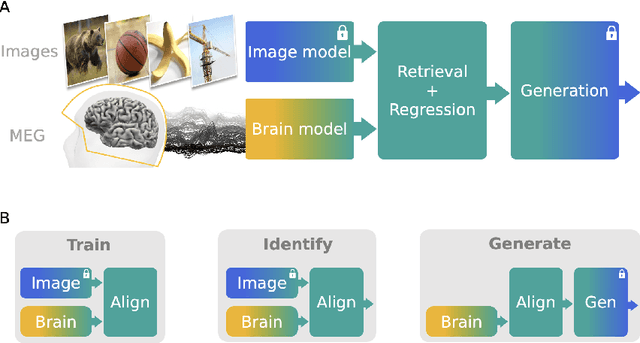

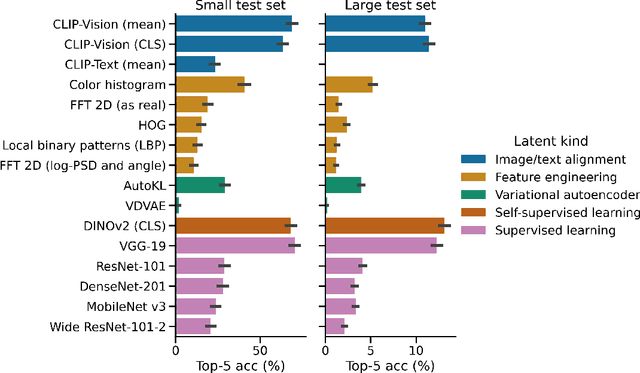
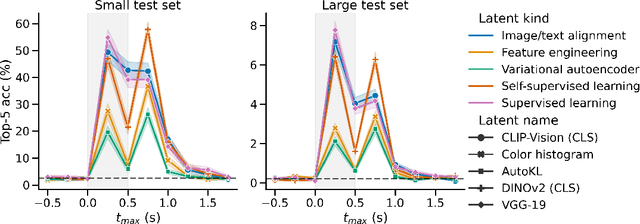
Abstract:In the past five years, the use of generative and foundational AI systems has greatly improved the decoding of brain activity. Visual perception, in particular, can now be decoded from functional Magnetic Resonance Imaging (fMRI) with remarkable fidelity. This neuroimaging technique, however, suffers from a limited temporal resolution ($\approx$0.5 Hz) and thus fundamentally constrains its real-time usage. Here, we propose an alternative approach based on magnetoencephalography (MEG), a neuroimaging device capable of measuring brain activity with high temporal resolution ($\approx$5,000 Hz). For this, we develop an MEG decoding model trained with both contrastive and regression objectives and consisting of three modules: i) pretrained embeddings obtained from the image, ii) an MEG module trained end-to-end and iii) a pretrained image generator. Our results are threefold: Firstly, our MEG decoder shows a 7X improvement of image-retrieval over classic linear decoders. Second, late brain responses to images are best decoded with DINOv2, a recent foundational image model. Third, image retrievals and generations both suggest that MEG signals primarily contain high-level visual features, whereas the same approach applied to 7T fMRI also recovers low-level features. Overall, these results provide an important step towards the decoding - in real time - of the visual processes continuously unfolding within the human brain.
Language acquisition: do children and language models follow similar learning stages?
Jun 06, 2023



Abstract:During language acquisition, children follow a typical sequence of learning stages, whereby they first learn to categorize phonemes before they develop their lexicon and eventually master increasingly complex syntactic structures. However, the computational principles that lead to this learning trajectory remain largely unknown. To investigate this, we here compare the learning trajectories of deep language models to those of children. Specifically, we test whether, during its training, GPT-2 exhibits stages of language acquisition comparable to those observed in children aged between 18 months and 6 years. For this, we train 48 GPT-2 models from scratch and evaluate their syntactic and semantic abilities at each training step, using 96 probes curated from the BLiMP, Zorro and BIG-Bench benchmarks. We then compare these evaluations with the behavior of 54 children during language production. Our analyses reveal three main findings. First, similarly to children, the language models tend to learn linguistic skills in a systematic order. Second, this learning scheme is parallel: the language tasks that are learned last improve from the very first training steps. Third, some - but not all - learning stages are shared between children and these language models. Overall, these results shed new light on the principles of language acquisition, and highlight important divergences in how humans and modern algorithms learn to process natural language.
Decoding speech from non-invasive brain recordings
Aug 25, 2022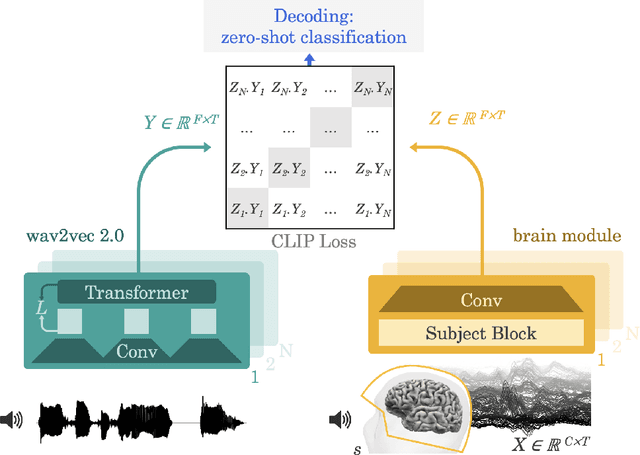

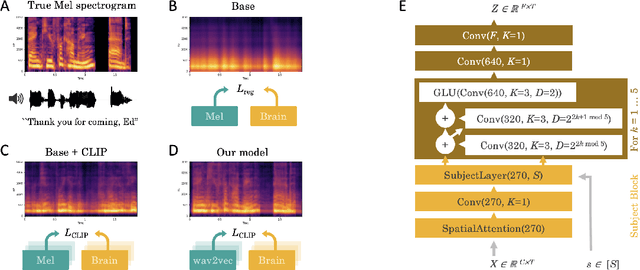

Abstract:Decoding language from brain activity is a long-awaited goal in both healthcare and neuroscience. Major milestones have recently been reached thanks to intracranial devices: subject-specific pipelines trained on invasive brain responses to basic language tasks now start to efficiently decode interpretable features (e.g. letters, words, spectrograms). However, scaling this approach to natural speech and non-invasive brain recordings remains a major challenge. Here, we propose a single end-to-end architecture trained with contrastive learning across a large cohort of individuals to predict self-supervised representations of natural speech. We evaluate our model on four public datasets, encompassing 169 volunteers recorded with magneto- or electro-encephalography (M/EEG), while they listened to natural speech. The results show that our model can identify, from 3s of MEG signals, the corresponding speech segment with up to 72.5% top-10 accuracy out of 1,594 distinct segments (and 44% top-1 accuracy), and up to 19.1% out of 2,604 segments for EEG recordings -- hence allowing the decoding of phrases absent from the training set. Model comparison and ablation analyses show that these performances directly benefit from our original design choices, namely the use of (i) a contrastive objective, (ii) pretrained representations of speech and (iii) a common convolutional architecture simultaneously trained across several participants. Together, these results delineate a promising path to decode natural language processing in real time from non-invasive recordings of brain activity.
 Add to Chrome
Add to Chrome Add to Firefox
Add to Firefox Add to Edge
Add to Edge